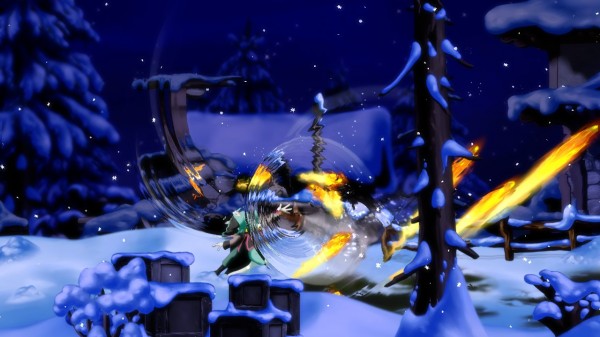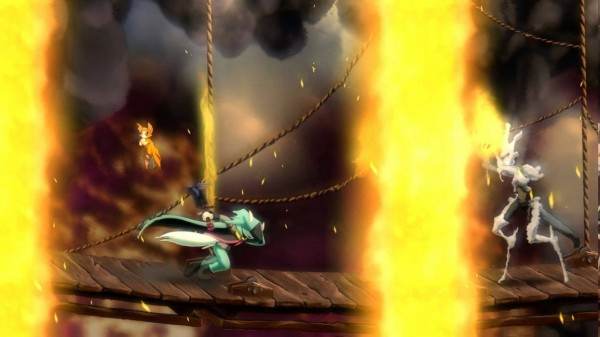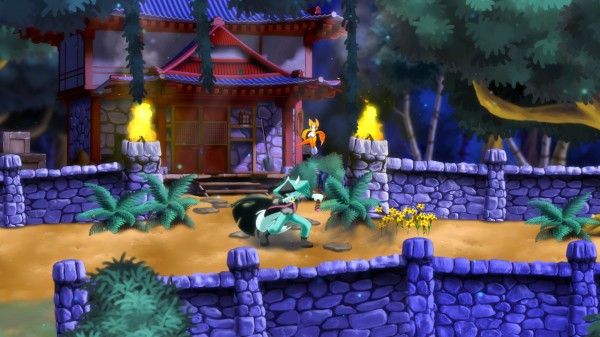
Dust: An Elysian Tail Xbox 360 Review
There is no doubt that Dust: An Elysian Tail has taken its sweet time to make its way onto Xbox Live Arcade. While it has not taken as long as Fez (announced 2007, released 2012), Dust first made a splash when it won Microsoft’s XNA focused Dream-Build-Play competition back in 2009, earning Dean Dodrill $40,000 to help finish the project. Since then, Dean has pretty much been a one-man army, dedicating himself to polishing up An Elysian Tail and getting the game out on sale. Fortunately, his efforts were not in vain; the title is now a part of the Xbox 360’s Summer of Arcade line up. In my opinion, the four-year wait was well worth it. Dust: An Elysian Tail is the best game in the Summer of Arcade 2012 selection – might not be the best praise to give when you think about the other picks – and you are going to find out why, right now.
Waking up in the middle of a forest, Dust, the game’s amnesiac, animal hero, has no idea what has happened and is confused when a flying, speaking sword comes to greet him. Branded with the name Ahrah, the sword tells Dust that he is now the master of the weapon because somehow Dust had summoned him. Closely behind this magical blade is Fidget, a hyperactive, flying cat like creature that is trying to return the sword back to her village before her people notice something is missing. After some chitchat, the group decides to assist Dust in finding out more about him, as well as the reason why monsters inhabit the world. While the story does not begin well, it becomes more interesting as you progress further, make sense of your surroundings, and learn about the main character, Dust.

An Elysian Tail falls into a gameplay category that gamers call “Metroidvania,” a reference to Metroid and Castlevania games and their distinctive gameplay style. For me, the gameplay in An Elysian Tail strongly resembles Muramasa: The Demon Blade, which saw release for the Nintendo Wii. Like that game, An Elysian Tale blends the Metroidvania gameplay with more of an action, hack and slash based combat blended with RPG elements. If you have never played any of these titles then let me explain: The gameplay resembles a side scrolling platformer, where the character is free to go left and right without any time restraints. The map on display on the top right corner of the screen splits into grids, with each grid representing a small part of the overall map for a zone. Players obtain rewards for navigating grids by finding secret treasures, pathways and cameo appearances from certain indie characters hidden deep within the game.
A big part of An Elysian Tail’s gameplay is the hyperactive fighting that centres around chaining combos to capitalise on max damage and experience points. Combat is misleading at first because you start with a simple string of combos assigned to the X button. It is not too long before you receive the Dust Storm, a move that activates when tapping the Y button, allowing Dust to spin his sword and create a mini wind of air like a windmill. An air version also becomes available and allows Dust to dash in the air, giving the opportunity to extend air combos. The developer could have left it at that, and it would have been a shallow, but fun button masher, but the combat goes deeper, almost making An Elysian Tail’s fighting mechanics look like a 2D version of Devil May Cry or Ninja Gaiden. However, combat is restricted due to the 2D plane, and with most enemies easily beaten, the game requires less skill than the above titles – still, it makes fighting with Dust an entertaining time.

The reason why I say the above is due to the advanced features of Dust’s set of moves. One I really like is the implementation of the parry system, a truly helpful skill that requires the player to attack at the same time as the enemy, but keep the X button held done after, so that only one slash comes out. Managing to do so will cause a flash and the enemy will be dazed, causing him to take ridiculous amount of damage. Parry is not worth using on the smaller, weaker enemies, but for the big ones that take much longer to kill with basic combos. The opportunity is available to kill the tougher enemies with normal attacks, but this is less rewarding compared to learning the parry, which gets rid of the challenging menace in a tenth of the time.
Another useful skill is Fidget’s magic attack that drains energy from a metre – energy is also used for dodging attacks, but it does recharge fairly fast so there’s no worry about overusing it – and allows her to send out a small magic attack, such as fireballs. Fidget’s moves are weak, and to gain the most use out of them requires Dust to activate the Dust Storm. Doing so sucks in the balls and causes them to multiply tenfold and fly all over the screen like some mini snowballs of death that hit for tiny amounts of damage. There are different magic types to use, such as the pillars of fire, but either way, no matter which one is active, you can rack up combos that go way past 100 and that in turn give Dust bonus experience points.

This is where the RPG elements come in. Each time Dust levels up, he receives a gem that allows the player to increase one of four stats – health, attack, defense and fidget’s magic damage. Equipping armor, pendants, and rings found in chests or shops can also help in increasing stats. Enemies and chests also drop materials that can create new equipment once combined with blue prints. It is these additional things that make An Elysian Tail more fun to play and give incentive to go and find hidden areas in the game’s levels and get that 100% plus (yes, it goes higher than 100%) completion.
While I have praised the game mostly so far, An Elysian Tail is not without some problems. I found playing on the normal difficulty rather easy, rarely feeling the danger of dying. If you are good at action games then I recommended moving it up to the next difficulty, Tough, to get more of a challenge. Also, and this tip is for people who do not pay attention well, players will have to keep a good eye out on the health bar because the game doesn’t do much to alert you when you are close to dying. For me, it was when I was in the heat of battle; I would forget how my health was doing because I was fixated on the action on display. Out of nowhere I would just die, it is slightly annoying, but something you have to adjust to as it is part of the game.

Revisiting areas later on does not adjust the enemies to a newly powered Dust, causing them to become one hit punch bags while you concentrated on looking for hidden areas using the new abilities you did not have back then. Even with these snags, I feel that the game is mostly a great experience from start to finish without that much bringing it down.
If there is one thing exceptional about the game then it is the visuals. Every year it seems there is a unique title whose visual charms stand to impress. For this year, that title is An Elysian Tail, a game that proves itself as a remarkable work of art. Gorgeous, stunning, magical – these are all words I would use to describe Dust when its charm and color combusts on the TV. It does not stop at the wonderful visuals; the animation is just as smooth and is a remarkable sight. This game runs at 60FPS and at 720p resolution, specs that certainly result in a game that is both pleasing to the eyes and technically sound. On the audio side, the soundtrack does not disappoint. The orchestral based music fits nicely with the aesthetics of the game, upping and downing the tempo and intensity when needed. Voice over is good for the most part, although I can imagine some people might find Fidget slightly annoying. I personally enjoyed her Saturday morning cartoon, sidekick approach, and she did not constantly poke me to listen, so that is a bonus.

In my mind there is no doubt that An Elysian Tail is a digital illustration of one person’s love and soul for this craft. Just looking at the finalized game and knowing that one person created all of this is mind blowing. That aside, the game itself is easily worth the 1200 Microsoft Points asking price, and with a decent length of around 8 hours (that is without doing all the side quests) gamers are getting great value for money.
Dust: An Elysian Tail is easily a recommendation for anyone who loves Metroidvania games, but even more so for people who just want fast platforming with speedy, arcade style combat that effectively blends the old with the new. Jaw-dropping presentation and art aside, Dust: An Elysian Tail is a delightful experience that deserves just as much attention from gamers as the designer put in when creating the title. Simply put, this great game is worth every moment of your time.
